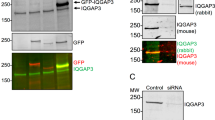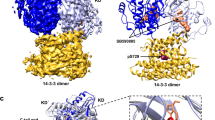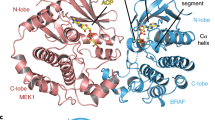Abstract
Rheb (Ras homolog enriched in brain) is a member of the Ras family of proteins, and is in the immediate Ras/Rap/Ral subfamily. We found in three different mammalian cell lines that Rheb was highly activated, to levels much higher than for Ras or Rap 1, and that Rheb's activation state was unaffected by changes in growth conditions. Rheb's high activation was not secondary to unique glycine to arginine, or glycine to serine substitutions at positions 14 and 15, corresponding to Ras residues 12 and 13, since Rheb R14G and R14G, S15G mutants had similarly high activation levels as wild type Rheb. These data are consistent with earlier work which showed that purified Rheb has similar GTPase activity as Ras, and suggest a relative intracellular deficiency of Rheb GTPase activating proteins (GAPs) compared to Rheb activators. Further evidence for relatively low intracellular GAP activity was that increased Rheb expression led to a marked increase in Rheb activation. Rheb, like Ras and Rap1, bound B-Raf kinase, but in contrast to Ras and Rap 1, Rheb inhibited B-Raf kinase activity and prevented B-Raf-dependent activation of the transcription factor Elk-1. Thus, Rheb appears to be a unique member of the Ras/Rap/Ral subfamily, and in mammalian systems may serve to regulate B-Raf kinase activity.
This is a preview of subscription content, access via your institution
Access options
Subscribe to this journal
Receive 50 print issues and online access
$259.00 per year
only $5.18 per issue
Buy this article
- Purchase on Springer Link
- Instant access to full article PDF
Prices may be subject to local taxes which are calculated during checkout





Similar content being viewed by others
References
Barbacid M . 1987 Annu. Rev. Biochem. 56: 779–827
Calés C, Hancock JF, Marshall CJ, Hall A . 1988 Nature 332: 548–551
Campbell SL, Khosravi-Far R, Rossman KL, Clark GF, Der CJ . 1998 Oncogene 17: 1395–1413
Catling AD, Reuter CWM, Cox ME, Parsons SJ, Weber MJ . 1994 J. Biol. Chem. 269: 30014–30021
Clark GJ, Kinch MS, Rogers-Graham K, Sebti SM, Hamilton AD, Der CJ . 1997 J. Biol. Chem. 272: 10608–10615
Dupuy AJ, Morgan K, von Lintig FC, Shen H, Acar H, Hasz DE, Jenkins NA, Copeland NG, Boss GR, Largaespada DA . 2001 J. Biol. Chem. 276: 11804–11811
Eychene A, Dusanter-Fourt I, Barnier JV, Papin C, Charon M, Gisselbrecht S, Calothy G . 1995 Oncogene 10: 1159–1165
Gromov PS, Madsen P, Tomerup N, Celis JE . 1995 FEBS Lett. 377: 221–226
Guha A, Lau N, Huvar I, Gutmann D, Provias J, Pawson T, Boss G . 1996 Oncogene 12: 507–513
Haugh JM, Huang AC, Wiley HS, Wells A, Lauffenburger DA . 1999 J. Biol. Chem. 274: 34350–34360
Jaiswal RK, Moodie SA, Wolfman A, Landreth GE . 1994 Mol. Cell. Biol. 14: 6944–6953
Jelinek T, Dent P, Sturgill TW, Weber MJ . 1996 Mol. Cell. Biol. 16: 1027–1034
Johnson NL, Gardner AM, Diener KM, Lange-Carter CA, Gleavy J, Jarpe MB, Minden A, Karin M, Zon LI, Johnson GL . 1996 J. Biol. Chem. 271: 3229–3237
Kuroda S, Ohtsuka T, Yamamori B, Fukui K, Shimizu K, Takai Y . 1996 J. Biol. Chem. 271: 14680–14683
Mach KE, Furge KA, Albright CF . 2000 Genetics 155: 611–622
Marais R, Light Y, Paterson HF, Mason CS, Marshall CJ . 1997 J. Biol. Chem. 272: 4378–4383
Mischak H, Seitz T, Janosch P, Eulitz M, Steen H, Schellerer M, Philipp A, Kolch W . 1996 Mol. Cell. Biol. 16: 5409–5418
Mizuki N, Kimura M, Ohno S, Miyata S, Sato M, Ando H, Ishihara M, Goto K, Watanabe S, Yamazaki M, Ono A, Taguchi S, Okumura K, Nogami M, Taguchi T, Ando A, Inoko H . 1996 Genomics 34: 114–118
Moodie SA, Paris MJ, Kolch W, Wolfman A . 1994 Mol. Cell. Biol. 14: 7153–7162
Papin C, Denouel-Galy A, Laugier D, Calothy G, Eychene A . 1998 J. Biol. Chem. 273: 24939–24947
Papin C, Denouel A, Calothy G, Eychene A . 1996 Oncogene 12: 2213–2221
Papin C, Eychene A, Brunet A, Pages G, Pouyssegur J, Calothy G, Barnier JV . 1995 Oncogene 10: 1647–1651
Pilz RB, Huvar I, Scheele JS, Van den Berghe G, Boss GR . 1997 Cell Growth Differ. 8: 53–59
Prigent SA, Nagane M, Lin H, Huvar I, Boss GR, Feramisco JR, Cavenee WK, Su Huang H-J . 1996 J. Biol. Chem. 271: 25639–25645
Pritchard CA, Samuels ML, Bosch E, McMahon M . 1995 Mol. Cell. Biol. 15: 6430–6431
Qiu W, Zhuang S, von Lintig FC, Boss GR, Pilz RB . 2000 J. Biol. Chem. 275: 31921–31929
Quilliam LA, Der CJ, Clark R, O'Rourke EC, Zhang K, McCormick F, Bokoch GM . 1990 Mol. Cell. Biol. 10: 2901–2908
Reuter CWM, Catling AD, Jelinek T, Weber MJ . 1995 J. Biol. Chem. 270: 7644–7655
Reuther GW, Der CJ . 2000 Curr. Opin. Cell Biol. 12: 157–165
Satoh T, Endo M, Nakafuko M, Akyama T, Yamamoto T, Kaziro Y . 1990a Proc. Natl. Acad. Sci. USA 87: 7926–7929
Satoh T, Endo M, Nakafuko M, Nakamura S, Kaziro Y . 1990b Proc. Natl. Acad. Sci. USA 87: 5993–5997
Scheele JS, Pilz RB, Quilliam LA, Boss GR . 1994 J. Biol. Chem. 269: 18599–18606
Scheele JS, Rhee JM, Boss GR . 1995 Proc. Natl. Acad. Sci. USA 92: 1097–1100
Sharma PM, Egawa K, Huang Y, Martin JL, Huvar I, Boss GR, Olefsky JM . 1998 J. Biol. Chem. 273: 18528–18537
Suhasini M, Li H, Lohmann SM, Boss GR, Pilz RB . 1998 Mol. Cell. Biol. 18: 6983–6994
Tian W, Boss GR, Cohen DM . 2000 Am. J. Physiol. 278: 372–380
Urano J, Ellis C, Clark GJ, Tamanoi F . 2001 Methods Enzymol. 333: 217–231
Urano J, Tabancay AP, Yang W, Tamanoi F . 2000 J. Biol. Chem. 275: 11198–11206
von Lintig FC, Pilz RB, Boss GR . 2000 Oncogene 19: 4029–4034
Vossler MR, Yao H, York RD, Pan M-G, Rim CS, Stork PJS . 1997 Cell 89: 73–82
White MA, Nicolette C, Minden A, Polverino A, Van Aeist L, Karin M, Wigler MH . 1995 Cell 80: 533–541
Yamagata K, Sanders LK, Kaufmann WE, Yee W, Barnes CA, Nathans D, Worley PF . 1994 J. Biol. Chem. 269: 16333–16339
Yee WM, Worley PF . 1997 Mol. Cell. Biol. 17: 921–933
Acknowledgements
This work was supported in part by USPHS Grants GM55586 (to RB Pilz), CA76968 and CA81115 (to GR Boss) and MH53608 (to PF Worley); E Im was supported by a UCSD Institute for Research on Aging Scholarship. We thank G Johnson, M Karin, L Quilliam, P Stork and M Wigler for generously providing the indicated plasmids.
Author information
Authors and Affiliations
Corresponding author
Rights and permissions
About this article
Cite this article
Im, E., von Lintig, F., Chen, J. et al. Rheb is in a high activation state and inhibits B-Raf kinase in mammalian cells. Oncogene 21, 6356–6365 (2002). https://doi.org/10.1038/sj.onc.1205792
Received:
Revised:
Accepted:
Issue Date:
DOI: https://doi.org/10.1038/sj.onc.1205792
Keywords
This article is cited by
-
The rapid proximity labeling system PhastID identifies ATP6AP1 as an unconventional GEF for Rheb
Cell Research (2024)
-
Mechanistic target of rapamycin (mTOR): a potential new therapeutic target for rheumatoid arthritis
Arthritis Research & Therapy (2023)
-
An oncogenic mutant of RHEB, RHEB Y35N, exhibits an altered interaction with BRAF resulting in cancer transformation
BMC Cancer (2018)
-
Analysis of TSC1 mutation spectrum in mucosal melanoma
Journal of Cancer Research and Clinical Oncology (2018)
-
Signal integration in the (m)TORC1 growth pathway
Frontiers in Biology (2018)



